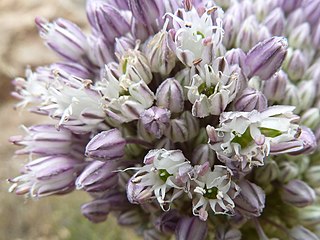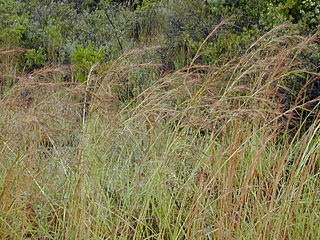
Apocynaceae is a family of flowering plants that includes trees, shrubs, herbs, stem succulents, and vines, commonly known as the dogbane family, because some taxa were used as dog poison. Members of the family are native to the European, Asian, African, Australian, and American tropics or subtropics, with some temperate members. The former family Asclepiadaceae is considered a subfamily of Apocynaceae and contains 348 genera. A list of Apocynaceae genera may be found here.

Allium ampeloprasum is a member of the onion genus Allium. The wild plant is commonly known as wild leek or broadleaf wild leek. Its native range is southern Europe to western Asia, but it is cultivated in many other places and has become naturalized in many countries.

Nicholas Edward Brown was an English plant taxonomist and authority on succulents. He was also an authority on several families of plants, including Asclepiadaceae, Aizoaceae, Labiatae and Cape plants.

Alepidea peduncularis is an edible perennial herb native to the montane grasslands of East and South Africa.

Caralluma is a genus of flowering plants in the family Apocynaceae, consisting of about 120 species.

Caralluma adscendens is a succulent plant in the family Apocynaceae. Its distribution ranges from India and Sri Lanka through the Arabian peninsula to North Africa and the Sahel.

Amaranthus graecizans, the Mediterranean amaranth or short-tepalled pigweed, is an annual species in the botanical family Amaranthaceae. It is native to Africa, southern Europe, East Asia to India and Central Asia. It is naturalized in North America. More general common names include tumbleweed and pigweed.

Commelina benghalensis, commonly known as the Benghal dayflower, tropical spiderwort, or wandering Jew, kanshira in Bengali, is a perennial herb native to tropical Asia and Africa. It has been widely introduced to areas outside its native range, including to the neotropics, Hawaii, the West Indies and to both coasts of North America. It has a long flowering period, from spring to fall in subtropical areas, and throughout the year closer to the equator. It is often associated with disturbed soils.

Hyparrhenia is a genus of grasses. Many species are known commonly as thatching grass.
Lasiurus is a genus of Asian and African plants in the grass family, Poaceae, found primarily in arid regions. The only known species is Lasiurus scindicus, native to drier regions of northern Africa and southwestern Asia, from Morocco and Mali to India.
Ochthochloa is a genus of desert plants in the grass family native to the Sahara and Arabian Deserts. The only known species is Ochthochloa compressa, whose native range extends from Algeria to Uttarakhand.
Edulis, edible in Latin, is a species name present in a number of Latin species names:
Blyxa aubertii, common name bamboo plant, is a plant species widespread across Asia, Europe, Africa and Australia, but known from the Western Hemisphere only from a few collections in the southwestern part of the US State of Louisiana. This is an aquatic plant growing in shallow lakes and ponds. This and other species in the genus are sold commercially as greenery to grow alongside fish in aquaria.
Sida mysorensis, common name in India Mysore fanpetals, is a plant species native to South and Southeast Asia. It has been reported from the wild in Indonesia, Vietnam, Laos, Cambodia, Thailand, India, Pakistan and southern China, and is cultivated elsewhere. It grows in grassy slopes, on roadsides, and in forest boundaries.
Allium humile is an Asian species of wild onion found at high elevations in India, Nepal, northern Pakistan, Tibet, and Yunnan.
Allium gilgiticum is an Asian species of onion, a rare and quite possibly extinct species. It is known only from the type collection, gathered in the 1930s in Gilgit District in Pakistan, high in the Himalayas, part of the Kashmir region long disputed with India. The plant is about 50 cm tall, with a hemispheric umbel of purple flowers.
Tenaris is a genus of plant in family Apocynaceae, first described as a genus in 1838. It is native to southern Africa.
- Tenaris brownianaS. Moore - Angola
- Tenaris chloranthaSchltr. - South Africa
- Tenaris filifolia(Schltr.) N.E. Br. - South Africa
- Tenaris schultzei(Schltr.) E. Phillips - Kalahari Desert
- Tenaris rubella, syn of Brachystelma rubellum
- Tenaris simulans, syn of Brachystelma rubellum
- Tenaris subaphylla, syn of Caralluma edulis
Orbeopsis is a genus of plants in the Apocynaceae, first described as a genus in 1978. They are native to southern Africa.
- Orbeopsis albocastanea(Marloth) L.C. Leach - Great Namaqualand in Namibia
- Orbeopsis gerstneri(Letty) L.C. Leach - KwaZulu-Natal
- Orbeopsis knobelii(Phillips) L.C. Leach - Botswana
- Orbeopsis melanantha(Schltr.) L.C. Leach - South Africa
- Orbeopsis valida(N.E. Br.) L.C. Leach - Zimbabwe

Orthanthera is a genus of plants in the family Apocynaceae, first described as a genus in 1834. It is native to India and Africa.
- Orthanthera albidaSchinz - Namibia
- Orthanthera butayei(De Wild.) Werderm. - Zaire
- Orthanthera gossweileriC.Norman - Angola
- Orthanthera jasminiflora(Decne.) N.E.Br. ex Schinz - South Africa
- Orthanthera strictaHiern - Angola
- Orthanthera vimineaWight - Uttar Pradesh in India









